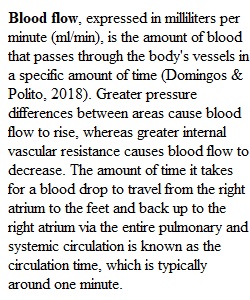


Q Blood Flow and Pressure Regulation The body is in a constant state of homeostatic maintenance. Blood pressure needs to be just high enough to meet the demands of the tissues and organs, but not so high that it damages blood vessels. The body has mechanisms to keep blood pressure levels within ideal parameters. Research the relationship between blood pressure, cardiac output, peripheral resistance, and hemodynamics. Create a visual presentation or an infographic that demonstrates the relationship between these processes. Requirements: Create a visual presentation or an infographic. If you create a presentation, it must be 8-10-slides in length, not including the title and reference slides, which are required. The presentation MUST include notes containing 80-100 words per slide. You will find resources focused on helping create visual presentations on the Visual Presentation page (Links to an external site.) located in the CSU Global Writing Center. If you create an infographic, it must include accompanying notes containing 200-400 words. You can also find information regarding creating infographics on the CSU Global guidelines for creating an infographic page (Links to an external site.). Your presentation or infographic must be properly cited and formatted according to APA guidelines in the CSU Global Writing Center (Links to an external site.). Include formal references with at least two scholarly references in addition to the course textbook. The CSU Global Library is a good place to find these references. If you create your presentation using Prezi, SlideShare, or some other web-based presentation tool, you will need to copy the link to your presentation with script notes and paste it into a Word document with a brief note to your instructor regarding the link and any special instructions for viewing your project once opened.
View Related Questions